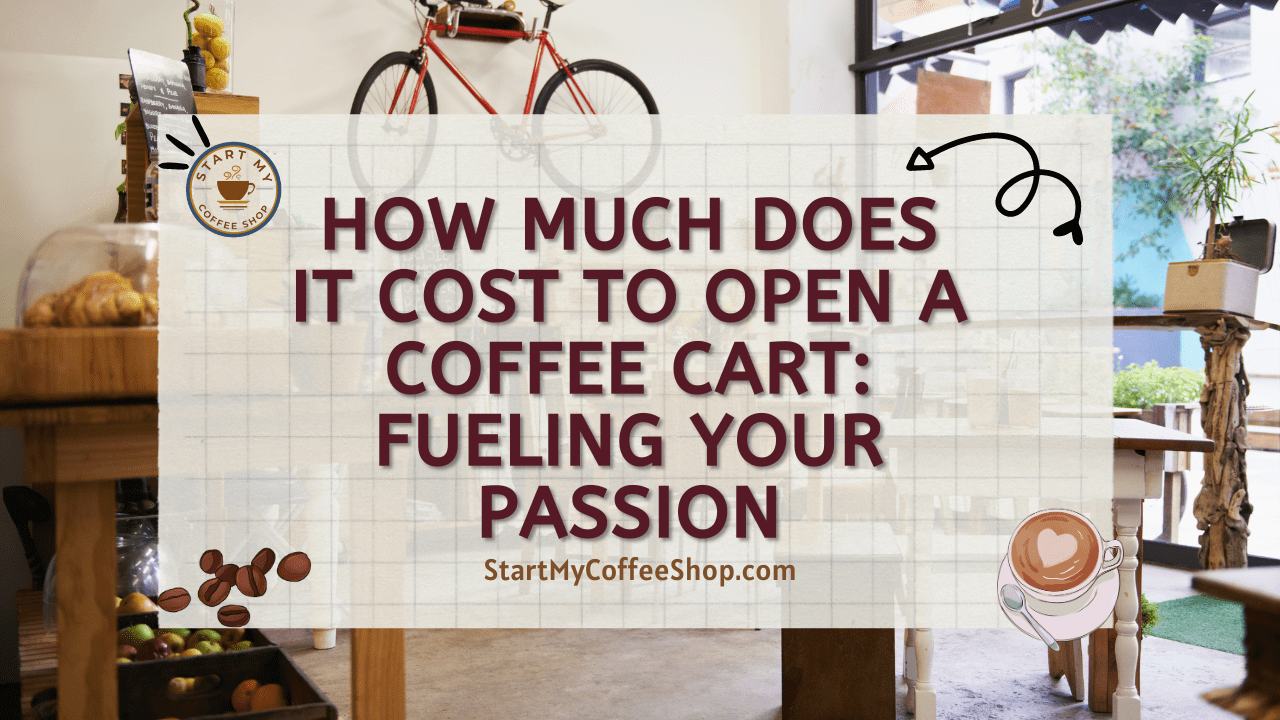Coffee carts have become a popular business option for aspiring entrepreneurs in the food and beverage industry. The ability to serve freshly brewed coffee on the go, combined with the lower startup costs compared to brick-and-mortar cafes, makes coffee carts an attractive venture.
The estimated cost varies quite a bit, my friend. It can range from $5,000 to $30,000 or even more. But hey, remember, there’s no one-size-fits-all answer. The final cost depends on factors like equipment quality, permits, supplies, and those sneaky unexpected expenses.
In this article, I will explore the various factors that contribute to the cost of opening a coffee cart and provide an overview of the potential expenses involved.
1. Market Research and Planning
 Before delving into the financial considerations of opening a coffee cart, it is crucial to prioritize thorough market research and the creation of a comprehensive business plan. This preliminary step serves multiple purposes, aiding in the identification of your target market, evaluation of existing competition, and exploration of potential locations for your coffee cart venture.
Before delving into the financial considerations of opening a coffee cart, it is crucial to prioritize thorough market research and the creation of a comprehensive business plan. This preliminary step serves multiple purposes, aiding in the identification of your target market, evaluation of existing competition, and exploration of potential locations for your coffee cart venture.
Dedicate ample time and resources to conduct this research and planning phase as it forms the bedrock of your business, enabling you to estimate costs more accurately.
Market research allows you to gain insights into consumer preferences, trends, and demands within your chosen area of operation. By analyzing the local coffee market, identifying gaps or opportunities, and understanding customer behavior, you can tailor your offerings and marketing strategies to effectively meet their needs.
Simultaneously, evaluating existing competitors provides invaluable information about their strengths, weaknesses, pricing strategies, and customer base. This analysis helps you position your coffee cart uniquely and develop a competitive advantage that sets you apart from others.
Identifying potential locations for your coffee cart involves considering factors such as foot traffic, nearby businesses, demographics, and local regulations. Conducting site visits, speaking with property owners or authorities, and seeking feedback from locals can help you gauge the suitability and viability of each location.
By investing in market research and crafting a comprehensive business plan, you establish a solid foundation for your coffee cart venture. Not only does this enhance your understanding of the industry landscape, but it also aids in estimating costs more accurately.
2. Equipment and Supplies
 When it comes to opening a coffee cart, one of the key financial considerations revolves around the cost of equipment and supplies. This encompasses a range of items, including the coffee machine, grinders, refrigeration units, water tanks, storage containers, and various tools necessary for preparing and serving coffee.
When it comes to opening a coffee cart, one of the key financial considerations revolves around the cost of equipment and supplies. This encompasses a range of items, including the coffee machine, grinders, refrigeration units, water tanks, storage containers, and various tools necessary for preparing and serving coffee.
The expense of these items can vary significantly depending on your budget and the desired quality of your coffee offerings. High-quality commercial-grade equipment, which ensures consistent and efficient operation, can range from a few thousand dollars to tens of thousands of dollars.
In addition to equipment, it is important to account for the ongoing cost of consumables. This includes coffee beans, milk, syrups, cups, lids, stirrers, napkins, and other supplies required for daily operations. These expenses can accumulate over time and should be factored into your budget.
To mitigate supply costs, it is recommended to establish relationships with local suppliers. By cultivating these partnerships and negotiating competitive prices, you can ensure a steady supply of high-quality ingredients and materials while keeping expenses in check.
Furthermore, it is wise to regularly review and assess your inventory needs to avoid wastage or overstocking. By closely monitoring consumption patterns and adjusting orders accordingly, you can optimize your supply management and maintain a healthy balance between meeting customer demand and minimizing unnecessary costs.
3. Cart Design and Construction
When setting up a coffee cart, the physical structure of your mobile establishment is an important factor that demands financial attention. Two options to consider are purchasing a pre-made cart or opting for a custom-designed one, based on your preferences and local regulations.
Pre-made coffee carts offer convenience and affordability, with prices typically ranging from $5,000 to $15,000. On the other hand, if you desire a unique cart tailored to your specific needs and branding, a custom-designed option is worth considering. However, it’s important to note that custom designs can come with a higher price tag, often starting at $20,000 or more.
In addition to the cart itself, it’s essential to factor in the cost of branding and signage. Creating an eye-catching and visually appealing cart plays a crucial role in attracting customers. This may involve designing a logo, selecting attractive colors, and incorporating signage that reflects your brand identity.
While the cost of branding and signage can vary depending on your specific requirements, it’s a worthwhile investment that contributes to your cart’s overall appeal and helps establish brand recognition among potential customers.
When making decisions about the physical structure of your coffee cart, carefully consider your budget, functional requirements, and the image you want to portray. Balancing cost-effectiveness with aesthetics and functionality will help you create an inviting and memorable coffee cart that stands out in the competitive market.
4. Permits and Licenses
Ensuring compliance with local regulations is of paramount importance when running a coffee cart business. Obtaining the necessary permits and licenses is a critical step that cannot be overlooked. The specific permits and licenses required may vary based on your jurisdiction but commonly include health permits, food handler’s permits, business licenses, and zoning permits.
Health permits are typically necessary to demonstrate that you meet the required hygiene and safety standards for handling and serving food and beverages. These permits may involve inspections and regular renewals. Food handler’s permits are often mandatory for individuals directly involved in food preparation and service. These permits ensure that the person handling food has received the necessary training and possesses the required knowledge to maintain food safety.
Business licenses are essential for legally operating your coffee cart. They establish your legitimacy as a business entity and grant you the right to conduct commercial activities. The cost of obtaining a business license varies depending on your location and the specific requirements set by local authorities.
Zoning permits determine where you can legally operate your coffee cart. Different areas may have zoning regulations that dictate where mobile businesses are allowed to set up shop. Researching and complying with these regulations will help you identify suitable locations and avoid potential legal issues.
When considering the financial aspects of opening a coffee cart, it is crucial to factor in the cost of permits and licenses. The fees associated with obtaining these permits can vary significantly depending on your location. They can range from a few hundred to a few thousand dollars. Researching the specific requirements in your area, engaging with local authorities, and budgeting for these costs will ensure that you are operating legally and avoid any penalties or setbacks in the future.
Read more about Cost to Open Coffee Shop Average: From Concept to Cash Register
5. Marketing and Promotion
Firstly, designing a logo that reflects your brand identity is important for creating a recognizable and cohesive visual representation. A professionally designed logo can range in cost depending on your specific requirements and the expertise of the designer.
Creating a website and setting up social media profiles are vital for establishing an online presence. These platforms allow you to showcase your menu, share updates, engage with potential customers, and even enable online ordering. The cost of website development can vary depending on the complexity of the site and whether you hire a professional or utilize DIY website builders. Social media platforms generally offer free account setup, but allocating a budget for social media advertising can help reach a wider audience.
Printing physical marketing materials like flyers or business cards is another avenue to explore. The cost of printing can vary based on the quantity, design complexity, and choice of materials.
Running targeted advertising campaigns can be an effective way to reach potential customers. Platforms such as social media advertising, search engine marketing, or local publications offer various advertising options with different pricing models. It’s essential to set a budget for advertising and continuously monitor and optimize campaigns to ensure they are delivering desired results.
While the specific costs of marketing and promotion will depend on your chosen strategies and scale, it is advisable to allocate a reasonable amount to establish your brand presence and effectively reach your target audience. Remember, a well-executed marketing and promotion plan will help drive awareness, increase customer engagement, and ultimately contribute to the progress of your coffee cart business.
6. Operational Costs
In addition to the initial setup expenses, it is essential to carefully consider the ongoing operational costs involved in running a coffee cart. These recurring expenses play a significant role in the long-term sustainability of your business.
Here are some key factors to consider:
- Rent or Lease Expenses: If you are operating your coffee cart in a designated space, you will likely have rent or lease expenses to consider. The cost of renting or leasing a parking space or a spot at a designated location can vary depending on the area and its demand.
- Utility Bills: Running a coffee cart requires utilities such as electricity, water, and possibly gas. These utility bills should be factored into your monthly expenses. Consider the usage requirements of your equipment and the average consumption to estimate these costs accurately.
- Insurance: Protecting your coffee cart business with the appropriate insurance coverage is crucial. General liability insurance, product liability insurance, and property insurance are some common types of coverage to consider. The cost of insurance premiums will depend on factors such as coverage limits, location, and the scope of your business operations.
- Maintenance and Repairs: Regular maintenance and occasional repairs are inevitable when operating any equipment. Budgeting for these costs ensures that you can promptly address any issues that arise and maintain the efficiency and safety of your coffee cart.
- Restocking Supplies: Keeping your coffee cart stocked with fresh ingredients, coffee beans, cups, napkins, and other supplies is vital. Consider the frequency of restocking and estimate the associated costs to maintain a consistent supply chain.
- Employee Wages: If you decide to hire employees to assist with the operation of your coffee cart, employee wages become a recurring cost. Factor in the number of employees, their hourly rates, and any additional benefits or taxes required by law.
Read more about Cost to Open Coffee Stand: Evaluating the Financial Commitment to a Coffee Stand
Summary
Opening a coffee cart can be an exciting entrepreneurial venture. While the costs involved can vary widely, taking the time to conduct thorough research, create a comprehensive business plan, and budget for the various expenses will help set you up for growth.
By considering factors such as equipment, supplies, cart design, permits, marketing, and ongoing operational costs, you can estimate the total investment required to open a coffee cart. With careful planning, dedication, and a love for coffee, you can embark on a journey to serve delicious brews to enthusiastic customers on the go. Cheers to your coffee cart dreams!
Frequently Asked Questions
Q: Do I need any specific permits or licenses to operate a coffee cart?
A: Yes. These may include health permits, food handler’s permits, business licenses, and zoning permits.
Q: How much should I budget for the ongoing operational costs of a coffee cart?
A: Beyond the initial setup expenses, it’s essential to consider ongoing operational costs. These include rent/lease expenses for your cart’s parking space, utility bills, insurance, maintenance and repairs, restocking supplies, and potentially employee wages if you decide to hire help.
Q: Can I customize the design of my coffee cart?
A: Absolutely! You have the flexibility to choose between pre-made coffee carts or custom designs.
To learn more on how to start your own coffee shop checkout my startup documents here
Please note: This blog post is for educational purposes only and does not constitute legal advice. Please consult a legal expert to address your specific needs.

Hi! I’m Shawn Chun
My adventure in coffee began when I first launched my first coffee shop back in the early 2000s. I had to figure out so many things on my own and to make it worse within 2 years of opening two large corporate coffee chains moved in just blocks away from me!
As I saw smaller and even some larger coffee shops in the neighborhood slowly lose customers to these giant coffee chains and slowly close up shop, I knew that I had to start getting creative…or go out of business.
I (like you may be) knew the coffee industry well. I could make the best latte art around and the foam on my caps was the fluffiest you have ever seen. I even had the best state-of-the-art 2 group digital Nuova Simonelli machine money could buy. But I knew that these things alone would not be enough to lure customers away from the name brand established coffee shops.
Eventually, through lots of trial and error as well as perseverance and creativity I did find a way to not only survive but also thrive in the coffee/espresso industry even while those corporate coffee chains stayed put. During those years I learned to adapt and always faced new challenges. It was not always easy, however, in the end, I was the sole survivor independent coffee shop within a 10-mile radius of my location. Just two corporate coffee chains and I were left after that year. All told the corporate coffee chains took down over 15 small independent coffee shops and kiosks and I was the last one standing and thriving.
Along the years I meet others with the same passion for coffee and I quickly learned that it is not only “how good a barista is” that makes a coffee shop successful, but the business side of coffee as well.
Hence why I started this website you are on now. To provide the tools and resources for up and coming coffee shop owners to gain that vital insight and knowledge on how to start a coffee shop successfully.
Stick around, browse through my helpful blog and resources and enjoy your stay! With lots of LATTE LOVE!
Shawn






